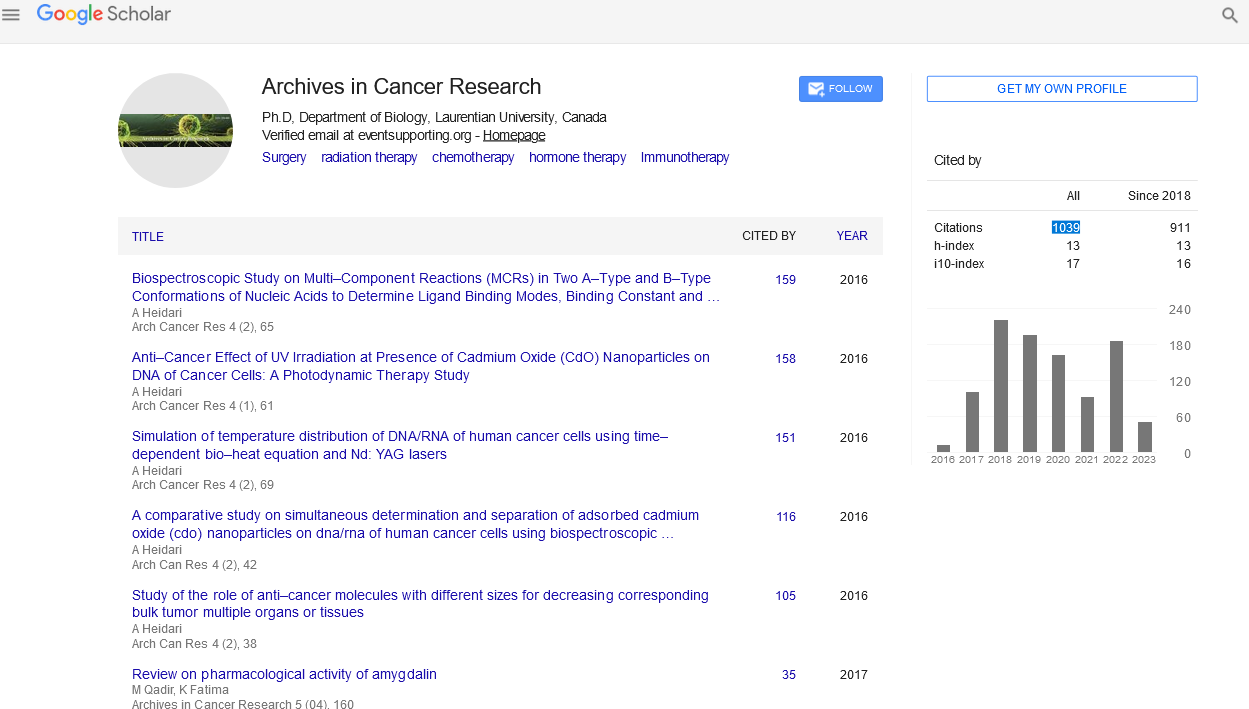A Heidari*
Faculty of Chemistry, California South University, 14731 Comet St. Irvine, CA 92604, USA
*Corresponding Author:
A Heidari
Faculty of Chemistry, California South
University, 14731 Comet St. Irvine, CA 92604, USA
Tel: +1-775-410-4974
E-mail: scholar.researcher.scientist@gmail.com
Received date: April 20, 2016; Accepted date: April 22, 2016; Published date: April 25, 2016
Citation: Heidari A. Biospectroscopic Study on Multi–Component Reactions (MCRs) in Two A–Type and B–Type Conformations of Nucleic Acids to Determine Ligand Binding Modes, Binding Constant and Stability of Nucleic Acids in Cadmium Oxide (CdO) Nanoparticles–Nucleic Acids Complexes as Anti–Cancer Drugs. Arch Cancer Res. 2016, 4:2.
Cadmium Oxide (CdO) nanoparticles are one of the most effective anti–cancer drugs. Cadmium Oxide (CdO) nanoparticles coordinate to nucleic acids and this coordination not only inhibits replication and transcription of nucleic acids, but also leads to programmed cancer cell death [1-10]. Cadmium Oxide (CdO) nanoparticles also form a coordination complex with nucleic acids, but unlike Palladium Oxide (PdO) nanoparticles is not an effective chemotherapeutic agent. This editorial was designed to compare the interactions of Cadmium Oxide (CdO) nanoparticles and Palladium Oxide (PdO) nanoparticles with Calf and Salmon thymus nucleic acids in aqueous solution at physiological conditions by Attenuated Total Reflectance Fourier Transform Infrared Spectroscopy (ATR–FTIR), FT–Raman, UV–Vis, HR Mass, 1HNMR, 13CNMR and 31PNMR spectroscopies which have used to determine binding constant and the stability of nucleic acids in drug–nucleic acids complexes in aqueous solution at physiological conditions. No biopolymer secondary structural changes were observed upon Cadmium Oxide (CdO) nanoparticles interaction and nucleic acids remain in the A–type conformation in these drug nanocompounds.
On the other hand, the development of multi–component reactions (MCRs) designed to produce elaborate biologically active compounds has become an important area of research in biomedical, biochemical, biophysical, clinical, pharmaceutical, physiological and photodynamic studies. Cadmium Oxide (CdO) nanoparticles are an interesting group of nanomaterials that exhibit extensive bioactivities such as scavenging free radical, anti–cancer and anti–proliferative effects. The anti–cancer and anti–viral effects of these nanoparticles are attributed to their potential biomedical, biochemical, biophysical, clinical, pharmaceutical, physiological and photodynamic applications.
Molecular systems with pre–organized and effectively functionalized recognition unit for guest molecules are ideal for host guest interaction. In this regard, nucleic acids provide particular promise due to their complexation ability and their applications receptors. While Cadmium Oxide (CdO) nanoparticles interact with nucleic acids; their bindings to nucleic acids are not fully studied. Also, this editorial was presented to test the interactions of Cadmium Oxide (CdO) nanoparticles with nucleic acids in aqueous solution at physiological conditions. Attenuated Total Reflectance Fourier Transform Infrared Spectroscopy (ATR– FTIR), FT–Raman, UV–Vis, HR Mass, 1HNMR, 13CNMR and 31PNMR spectroscopies were used to determine the ligand binding modes, the binding constant and the stability of nucleic acids in Cadmium Oxide (CdO) nanoparticles–nucleic acids complexes in aqueous solution at physiological conditions. No biopolymer secondary structural changes were observed upon Cadmium Oxide (CdO) nanoparticles interaction and nucleic acids remain in the B–type conformation in these drug nanocompounds.
9093
References
- Heidari A (2012) A thesis submitted to the Faculty of the Chemistry, California South University (CSU), Irvine, California, The United States of America (USA) in fulfillment of the requirements for the degree of Doctor of Philosophy (PhD) in Chemistry.
- Heidari A, Brown C (2015) Study of surface morphological, phytochemical and structural characteristics of rhodium (III) oxide (Rh2O3) nanoparticles. International Journal of Pharmacology, Phytochemistry and Ethnomedicine 1: 15–19.
- Heidari A (2015) Simulation of interaction of light and iridium nanoparticles using 3D finite element method (FEM) as an optothermal cancer cells treatment, International Journal of Theoretical, Computational and Mathematical Chemistry 1: 11–16.
- Heidari A, Brown C (2015) Study of composition and morphology of cadmium oxide (CdO) nanoparticles for eliminating cancer cells. Journal of Nanomedicine Research 2: 20.
- Heidari A (2016) A thermodynamic study on hydration and dehydration of DNA and RNA-amphiphile Complexes. J Bioeng Biomed Sci S: 006.
- Heidari A (2016) Future prospects of point fluorescence spectroscopy, fluorescence imaging and fluorescence endoscopy in Photodynamic Therapy (PDT) for cancer cells. J Bioanal Biomed 8: e135.
- Heidari A (2016) A bio–spectroscopic study of DNA density and color role as determining factor for absorbed irradiation in cancer cells. Adv Cancer Prev 1: e102.
- Heidari A (2016) Anti–cancer effect of UV irradiation at presence of Cadmium Oxide (CdO) nanoparticles on DNA of cancer cells: A Photodynamic therapy study. Archives in Cancer Research 4: 61.
- Heidari A (2016) Quantitative Structure–Activity Relationship (QSAR), Approximation for Cadmium Oxide (CdO) and Rhodium (III) Oxide (Rh2O3) nanoparticles as anti–cancer drugs for the catalytic formation of proviral DNA from viral RNA using multiple linear and non–linear correlation approach. Annals of Clinical and Laboratory Research 4: 76.
- A Heidari (2016) An analytical and computational infrared spectroscopic review of vibrational modes in nucleic acids. Austin J Anal Pharm Chem 3: 1058.





